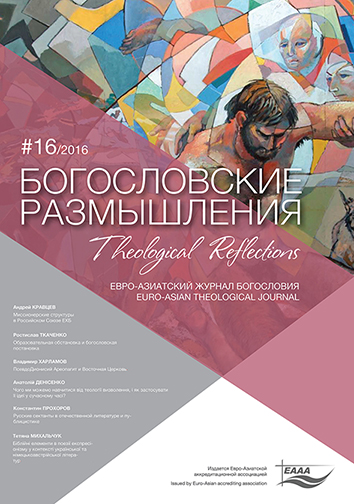Pseudo-Dionysius the Areopagite and Eastern Orthodoxy: Acceptance of the Corpus Dionysiacum and Integration of Neoplatonism into Christian Theology
DOI:
https://doi.org/10.29357/issn.2521-179X.2016.16.120Keywords:
Pseudo-Dionysius the Areopagite, Dionysian corpus, Eastern Orthodoxy, Neoplatonism, Christianity and Greek philosophy, Eastern Orthodox spiritualityAbstract
This essay will argue that the heritage of Pseudo-Dionysius the Areopagite represents the most living and widespread influence of Neoplatonic ideas in the Eastern Orthodox tradition. First, the attention will be given to the influence or placement of the Dionysian corpus in the midst of the cultural formation of Byzantine imperial Christian identity. This cultural pattern is still an important element of the mindset of Eastern Orthodoxy and, as a living experience of this tradition, it still constitutes a vibrant representation of the essentially Neoplatonic mentality. Second, the significance of Dionysian understanding of celestial and ecclesiastical hierarchies will be briefly addressed in view of their impact on metaphysical stratification of the world, theurgical connotation of church liturgy and clerical structuring of priestly ranks as the most characteristic elements inherited from Neoplatonism and expressly present in Eastern Orthodox spirituality.
References
- Dionisiĭ Areopagit. Korpus sochineniĭ s tolkovanii͡ami prep. Maksima Ispovednika [Dionisius Areopagite. A Corpus of Works with Maximus the Confessor's Commentaries]. – SPb.: Izdatel'stvo Olega Abyshko, 2010.
- Athanassiadi, Polymnia. “Dreams, Theurgy and Freelance Divination: The Testimony of Iamblichus.” The Journal of Roman Studies 83 (1993): 115–30.
- Berchman, R. M. From Philo to Origen: Middle Platonism in Transition. Chico, CA: Scholars Press, 1984.
- Corrigan, Kevin. Reading Plotinus: A Practical Introduction to Neoplatonism. West Lafayette, IN: Purdue University Press, 2005.
- De Vogel, C. J. “Platonism and Christianity: A Mere Antagonism or a Profound Common Ground?” Vigiliae Christianae 39 (1985): 1–62.
- Di Berardino, Angelo and Basil Studer, eds. History of Theology. Vol. 1 The Patristic Period. Collegeville, MN: The Liturgical Press, 1997.
- Golitzin, Alexander. Et Introibo Ad Altare Dei: The Mystagogy of Dionysius Areopagita: With Special Reference to Its Predecessors in the Eastern Christian Tradition. Thessaloniki: Patriarchikon Idruma Paterikõn Meletõn, 1994.
- Golitzin, Alexander with the collaboration of Bogdan G. Bucur. Mystagogy: A Monastic Reading of Dionysius Areopagita. Collegeville, MN: Liturgical Press, 2013.
- Harl, K. W. “Sacrifice and Pagan Belief in Fifth- and Sixth-Century Byzantium.” Past and Present 128 (1990): 7–27.
- Hathaway, Ronald F. Hierarchy and the Definition of Order in the Letters of Pseudo-Dionysius. A Study in the Form and Meaning of the Pseudo-Dionysian Writings. Hague: Nijhoff, 1969.
- Iamblichus. De Mysteriis, translated by Emma C. Clarke, John M. Dillon, and Jackson P. Hershbell. Atlanta, GA: Society of Biblical Literature, 2003.
- Kharlamov, Vladimir. The Beauty of the Unity and the Harmony of the Whole: The Concept of Theosis in the Theology of Pseudo-Dionysius the Areopagite. Eugene, OR: Wipf and Stock, 2009.
- Koch, Hugo. “Proklus als Quelle des Pseudo-Dionysius Areopagita in der Lehre vom Bösen.” Philologus 54 (1895): 438–54.
- ________. Pseudo-Dionysius Areopagita in Seinen Beziehungen zum Neuplatonismus und Mysterienwesen. 1900.
- Louth, Andrew. Denys the Areopagite. London: G. Chapman, 1989.
- ________. “Pagan Theurgy and Christian Sacramentalism in Denys the Areopagite.” Journal of Theological Studies 37 (1986): 432–38.
- McGinn, Bernard. The Foundations of Mysticism: Origins to the Fifth Century. New York: Crossroad, 1995.
- Meyendorff, John. Christ in Eastern Christian Thought. Crestwood, NY: St. Vladimir's Seminary Press, 1975.
- ________. “Continuities and Discontinuities in Byzantine Religious Thought.” Dumbarton Oaks Papers 47 (1993), 69–81.
- O’Meara, Dominic J., ed. Neoplatonism and Christian Thought. Albany, NY: State University of New York Press, 1982.
- Pseudo-Dionysius. Corpus Dionysiacum I: De Divinis Nominibus. Edited by Beate Regina Suchla. Patristische Texte und Studien 33. Berlin: Walter de Gruyter, 1990.
- ________. Corpus Dionysiacum II: De Coelesti Hierarchia, De Ecclesiastica Hierarchia, De Mystica Theologia, Epistulae. Edited by Günter Hail and Adolf Martin Ritter. Patristische Texte und Studien 36. Berlin: Walter de Gruyter, 1991.
- ________. The Complete Works. Translated by Colm Luibheid and Paul Rorem. The Classics of Western Spirituality. New York: Paulist Press, 1987.
- Rist, John. “Basil’s ‘Neoplatonism’: Its Background and Nature.” In Basil of Caesarea: Christian, Humanist, Ascetic, edited by Paul Jonathan Fedwick, 137–220. Toronto: Pontifical Institute of Medieval Studies, 1981.
- ________. “Plotinus and Christian Philosophy.” In The Cambridge Companion to Plotinus, edited by Lloyd P. Gerson, 386–413. Cambridge, UK: Cambridge University Press, 1999.
- Rorem, Paul and John Lamoreaux. John of Scythopolis and the Dionysian Corpus: Annotating the Areopagite. Oxford: Oxford University Press, 1998.
- Rosán, Laurence Jay. The Philosophy of Proclus: The Final Phase of Ancient Thought. New York: Cosmos Greek-American Printing Co., 1949.
- Shaw, Gregory. “Neoplatonic Theurgy and Dionysius the Areopagite.” Journal of Early Christian Studies 7 (1999): 573–99.
- Stiglmayr, Josef. “Der Neuplatoniker Proclus als Vorlage des sog. Dionysius Areopagita in der Lehre vom Übel.” Historisches Jahrbuch 16 (1895): 253–73, 721–48.
- Suchla, Beate Regina. “Die Überlieferung des Prologs des Johannes von Skythopolis zum griechischen Corpus Dionysiacum Areopagiticum: ein weiterer Beitrag zur Überlieferungsgeschichte des CD.” Nachrichten der Akademie Der Wissenschaften in Göttingen: Philologisch-Historische Klasse (1984), 4:176–88.
- Wallis, R. T. Neoplatonism, 2nd ed. Indianapolis, IN: Hackett Publishing Company, 1995.
- Wesche, Kenneth Paul. “Christological Doctrine and Liturgical Interpretation in Pseudo-Dionysius.” St. Vladimir’s Theological Quarterly 33 (1989): 53–73.
Downloads
How to Cite
Issue
Section
License
Copyright (c) 2020 Vladimir KНARLAMOV

This work is licensed under a Creative Commons Attribution-NonCommercial 4.0 International License.
All articles published in the Journal are distributed under a Creative Commons Attribution-NonCommercial 4.0 International License
By submitting an article for publication in Theological Reflections: Eastern European Journal of Theology the author grants the editors the right to publish the article and distribute it in electronic and print form.
The author reserves all copyrights and the right to use the materials of the article in whole or in part for educational purposes, to write his own dissertations, to prepare abstracts, conference reports, oral presentations, etc., as well as post electronic copies of articles (including the final electronic version downloaded from the journal’s official website) on non-commercial web-resources without the consent of the editorial board and founders.



